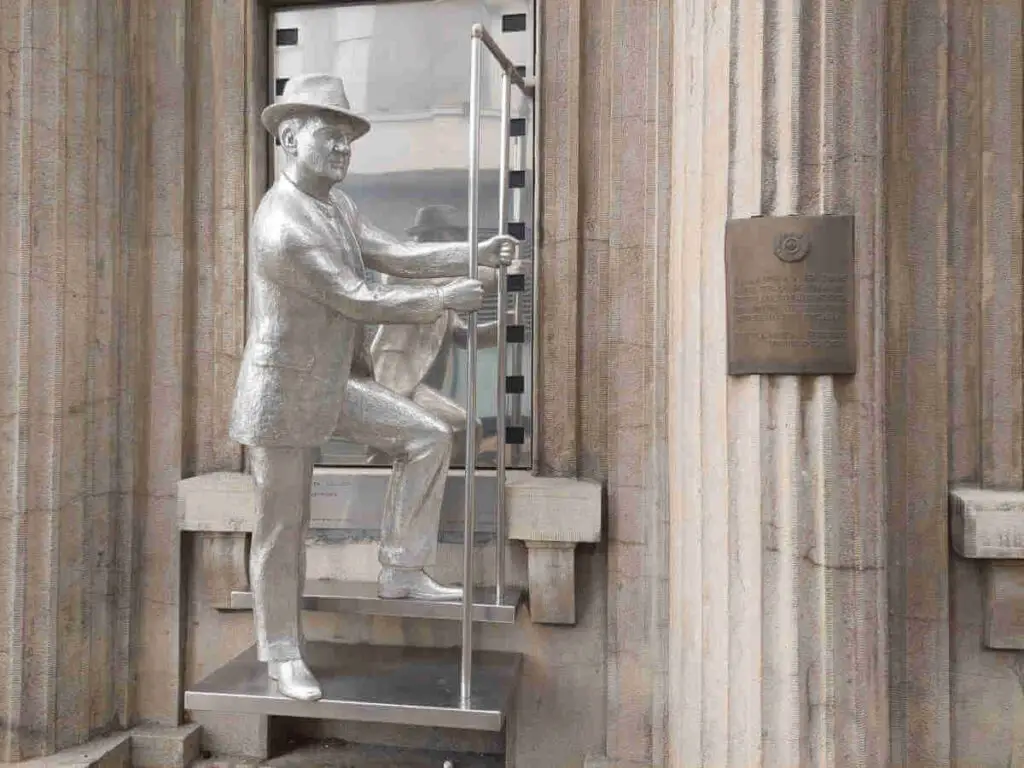As visitors wander through the heart of Belgrade, they encounter numerous monuments that reveal the turbulent history of the Serbian capital. However, one statue in particular often catches tourists by surprise—a life-size tribute to Hollywood actor Karl Malden, standing proudly in front of the Yugoslav Film Archive at Uzun Mirkova Street No. 1. Why did Serbia choose to honor one of the most recognizable American actors of the 20th century? The answer lies in his deep connection to his Serbian heritage, which shaped both his life and career.

Karl Malden’s Serbian Origin
Few people are aware that Karl Malden was born as Mladen Sekulović on March 22, 1912, in Chicago, Illinois, to a Serbian father, Petar, and a Czech mother, Minnie. His father’s family, the Sekulovićs, hailed from the village of Podosoje, near Bileća, in what is now Bosnia and Herzegovina.
Malden grew up speaking Serbian at home, and his family’s traditions and culture were an integral part of his upbringing. Actually, only in kindergarten did he start speaking English.
Malden remained deeply connected to his Serbian roots throughout his life. He visited the former Yugoslavia and often spoke of his pride in his heritage. The Hollywood actor expressed his love for his people with the words: “I am happy that I was born in a Serbian home, that I was baptized in a Serbian church, that I regularly attend it, that I sing in the Serbian choir, and that I can proudly say that I am Serbian.”
Name Change from Mladen Sekulović to Karl Malden

At 22, Mladen Sekulović changed his name to Karl Malden to make it more anglicized and easier to pronounce for Hollywood audiences. He rearranged the letters in his first name, “Mladen,” turning it into “Malden” and took his grandfather’s first name, Karl, as his own. Although the change helped him fit into the industry, Malden later regretted the decision and made a point of incorporating his original surname, Sekulović, into his work whenever possible.
A Brief Biography of Karl Malden

Karl Malden’s acting career spanned over six decades, during which he became known as one of Hollywood’s most respected and versatile character actors. After starting his acting career on Broadway in the late 1930s, Malden rose to prominence in the 1950s with a series of memorable roles in iconic films.
He won an Academy Award for Best Supporting Actor in 1951 for his role as Mitch in A Streetcar Named Desire, where he starred alongside Marlon Brando and Vivien Leigh. Malden’s performance as a sensitive, kind-hearted man trapped in a dysfunctional relationship with Leigh’s character earned him widespread acclaim and cemented his place in Hollywood.
He went on to star in other notable films such as On the Waterfront (1954), for which he received a second Best Supporting Oscar nomination, and Patton (1970), where he portrayed General Omar Bradley. Malden’s work extended to television, where he became a household name for his role as Detective Lt. Mike Stone in the long-running TV series The Streets of San Francisco (1972–1977).
Throughout his career, Malden was known for playing ordinary, everyman characters—working-class men, priests, police officers—imbued with a sense of dignity and strength. His distinctive voice and rugged features made him a familiar presence on screen, and he earned a reputation as an actor of great integrity and professionalism.
In addition to his acting career, Malden also served as President of the Academy of Motion Picture Arts and Sciences from 1989 to 1992, further solidifying his influence in Hollywood.
Karl Malden passed away on July 1, 2009, at the age of 97 in Los Angeles, leaving behind a remarkable legacy as an actor, husband, father, and proud Serbian-American.
The Karl Malden Monument in Belgrade

The statue of Karl Malden was unveiled in 2018 and is situated in front of the Yugoslav Film Archive (Jugoslovenska kinoteka) in Belgrade’s city center. The Film Archive is a fitting location, as it serves as a symbol of Serbia’s rich cinematic history, celebrating its great contributions to film and honoring international stars with Serbian heritage, such as Malden.
Designed by sculptor Zdravko Joksimović, the statue depicts Malden dressed in a suit, holding onto tram handles, with his gaze directed toward Kalemegdan.
This statue is not just a celebration of his career but a reminder of the deep ties between Malden and the Serbian community. Though born in the United States, Malden’s Serbian identity played a significant role in his life, and his legacy continues to resonate in Serbia.

The Yugoslav Film Archive also houses the legacy of Karl Malden, which includes personal items and some props from the Oscar-winning actor’s films—a plaque with a star from the Hollywood Walk of Fame, a letter from Marlon Brando, as well as the hat he wore as Detective Lt. Mike Stone in the series The Streets of San Francisco.
Conclusion
The statue of Karl Malden in Belgrade is more than just a monument to a Hollywood star. It’s a tribute to a man who embraced his Serbian heritage throughout his life, despite achieving fame in America. Located in front of the Yugoslav Film Archive, it stands as a bridge between Malden’s two worlds—his Serbian roots and his Hollywood career—celebrating both with grace and dignity.
For fans of cinema, the statue is a must-see when visiting Belgrade, offering a chance to honor one of the greats of the silver screen while also acknowledging the cultural ties that unite people across the globe.


Leave a Reply